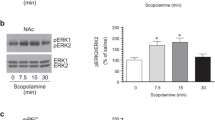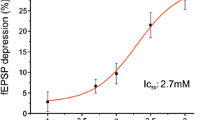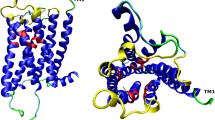Abstract
The distribution and down-regulation of the muscarinic acetylcholine receptor (mAChR) were studied in dissociated cells from right (RCC) and left (LCC) cerebral cortex. For this purpose [3H]quinuclidinyl benzilate (QNB) and [3H]pirenzepine (Pz), two muscarinic antagonists, were used. The mAChR binding sites detected with [3H]QNB were asymmetrically distributed between the two hemispheres, the majority being found in the RCC. Asymmetry was also evident in the distribution of the mAChR subtypes (M1 and M2) detected with [3H]Pz. Under basal conditions the RCC had roughly 50% more M1 subtype than the LCC. The pharmacological and kinetic parameters were similar for both antagonists in RCC and LCC, indicating that the observed lateralization was due to a different density of the receptor rather than to different kinetics of binding of the two radioligands. After sustained stimulation with the agonist carbamoylcholine, the receptor sites detected with [3H]Pz, i.e. the M1 subtype of mAChR, decreased at a higher rate in the RCC (44%) than in the LCC (25% of controls), demonstrating that the down-regulation process is more active in the right than in the left cortex, and thus implying that there is better coupling between the stimulated mAChR and its effector system in the former.
Similar content being viewed by others
References
Glick, S. D., Ross, D. A., and Hough, L. B. 1982. Lateral asymmetry of neurotransmitters in human brain. Brain Res. 234:53–63.
Geshwind, M., and Galaburda, A. M. 1985. Cerebral lateralization. Biological mechanisms, associations and pathology: I. A hypothesis and program for research. Arch. Neurol. 42:428–459.
Amaducci, L., Sorbi, S., Albanese, A., and Gainoti, G. 1981. Choline acetyl transferase (ChAT) activity differs in right and left human temporal lobes. Neurology 31:799–805.
Pediconi, M. F., and Rodriguez de Turco, E. B. 1984. Free fatty acid content and release kinetics as manifestation of cerebral lateralization in mouse brain. J. Neurochem 43:1–7.
Ginóbili de Martínez, M. S., Rodriguez de Turco, E. B. and Barrantes, F. J. 1986. Asymmetry of diacylglycerol metabolism in rat hemispheres. J. Neurochem. 46:1382–1386.
Feigenbaum, P. and El-Fakahany, E. 1985. Regulation of muscarinic cholinergic receptor density in neuroblastoma cells by different exposure to agonist: possible involvement of desensitization of receptor function. J. Pharmacol. Exp. Ther. 233:134–140.
Nathanson N. M., Klein, W. L. and Niremberg, M. 1978. Regulation of adenylate cyclase activity mediated by muscarinic acetylcholine receptors. Proc. Natl. Acad. Sci. 75:1788–1791.
Taylor, J. E., El-Fakahany, E., and Richelson, E. 1979. Long-term regulation of muscarinic acetylcholine receptors on cultured nerve cells. Life Sci. 25:2181–2187.
Taylor, J. E., Yaksh, T. L., and Richelson, E. 1982. Agonist regulation of muscarinic acetylcholine receptors in rat spinal cord. J. Neurochem. 39:521–527.
Klein, W. L., Nathanson, N. M., and Niremberg, M. 1976. Long-term receptor mediate regulation of acetylcholine receptor and adenylate cyclase in hybrid cells. Fed. Proc. 35:1576.
Richelson, E. 1984. Studying neurotransmitter receptors: binding and biological assaysin Karger, Basel (ed.), Monogr. Neural Sci. chap. 10, pp. 4–19.
Pediconi, M. F., and Barrantes, F. J. 1990. Brain, asymmetry in phospholipid polar head group metabolism: parallel in vivo and in vitro studies. Neurochem. Res. 15:25–32.
Fisher, S. K., Figueiredo, J. C., and Bartus, R. T. 1984. Differential stimulation of inositol phospholipid turnover in brain by analogs of oxotremorine. J. Neurochem. 43:1171–1179.
Lowry, O. H., Rosebrough, N. J., Parr, A. L., and Randall, R. S. 1951. Protein measurement with the Folin phenol reagent. J. Biol. Chem. 193:265–275.
Bennett, J. P., and Yamamura, H. I. 1985. Neurotransmitters, Hormones, or drug receptor binding methods. Pages 61–89,in Yamamura, Enna, and Kuhar, (eds.), Neurotransmitter receptor binding, 2nd. edition. Raven Press, N.Y.
Watson, M., Yamamura, H. Y., and Roeske, W. R. 1983. A unique regulatory profile and regional distribution of [3H]phenzepine binding in the rat provide evidence for distinct M1 and M2 muscarinic receptor subtypes. Life Sci. 32:3001–3011.
Messer, W. S., and Hoss, W. 1987. Selectivity of pirenzepine in the central nervous system. I. Direct autoradiographic comparison of the regional distribution of pirenzepine and carbamoylcholine binding sites. Brain Research 407:27–36.
Luthin, G. R., and Wolfe, B. B. 1984. [3H]-pirenzepine and [3H]-quinuclidinyl benzilate binding to rat muscarinic cholinergic receptors. Mol. Pharmacol. 26:164–169.
Bonner, T. I. 1989. The molecular basis of muscarinic receptor diversity. Trends Neurosci. 12:148–151.
Shifrin, G.S., and Klein, W.L. 1980. Regulation of muscarinic acetylcholine receptor concentration in cloned neuroblastoma cells. J. Neurochem. 34:993–999.
Liles, W. C., Hunter, D. D., Meier, K. E., and Nathanson, N. M. 1986. Activation of protein kinase C induces rapid internalization and subsequent degradation of muscarinic acetylcholine receptors in neuroblastoma cells. J. Biol. Chem. 261:5307–5313.
Lerer, B., Altman, M., and Stanley, M. 1984. Enhancement of memory by a cholinesterase inhibitor associated with muscarinic receptor down-regulation. Pharmacol. Biochem. Behav. 21:67–469.
Author information
Authors and Affiliations
Rights and permissions
About this article
Cite this article
Pediconi, M.F., Roccamo de Fernández, A.M. & Barrantes, F.J. Asymmetric distribution and down-regulation of the muscarinic acetylcholine receptor in rat cerebral cortex. Neurochem Res 18, 565–572 (1993). https://doi.org/10.1007/BF00966932
Accepted:
Issue Date:
DOI: https://doi.org/10.1007/BF00966932




